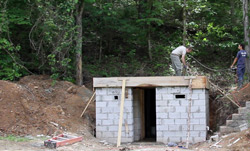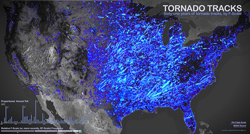
Emergency Preparedness on the Cheap
Below is a list of of gear that I have tested and evaluated. Most has been tested in Africa for several weeks.
Flashlights
In most emergencies the power goes out. Candles seem quaint and reassuring but give off almost no light and are a significant fire risk. Based on my experience your flashlight will probably be your most used and useful tool - if you have a good one, that is. Skip those cheap ones that come bundled with batteries; also skip the cheap “9 LED” types. I’d also avoid the lights that run on 3x AAA batteries - most eat batteries too quickly.
The most useful flashlight will use a Cree LED, have multiple modes (including a one with less than 10 lumens), and run on AA batteries. In my experience the best light that meets this criteria is the 4Sevens Quark AA2; it’s a little pricey at roughly $50, but it has a 10 year warranty. It will even run on dead batteries - not at full power, but “moon light” mode works great.
A cheaper option is the Gerber Infinity - it runs on a single AA battery and only has one dim mode, but lasts for a long time on that battery - I think it gets over 100 hours of run time.
One upgrade that I do to all my flashlights is to wrap the base of the light in some sort of grippy, soft, tape, like electrical tape. That way I can easily hold the light in my teeth and use it like a headlamp and free my hands.
Rechargeable Batteries
Even if you have a flashlight that’s pretty energy efficient you are going to need to eventually change batteries. And there are lots other useful devices that run on batteries like radios and water purifiers. That’s where modern rechargeable batteries come in. Eneloop is the most commonly known name, but the same technology is available from other companies - I’ve mostly used Tenergy batteries, which have worked great for me - they are also cheaper than the Eneloops.
You need a special charger for Nimh batteries; I’ve mostly used two: My main charger is made by Maha. It’s capable of charging at different speeds and reconditioning batteries. A good backup option is the Titanium 8 Bay charger - one great bonus to it is that it can run directly off 12V, like a car battery or cigarette lighter:
Power Generation
Of course, if you are planning to recharge your batteries you need a way to do that even when the power is off. Most people will say you need to buy a generator - preferably a big one that can run your whole house. The problem with that is the limited availability of gas following a disaster and the fact that gas has a very poor shelf life. For weeks after Sandy people had to wait in line to get gas - and often only five gallons of gas.
But almost everyone already has a generator of sorts: their car. It won’t replace a real generator (you can’t use it to run your fridge), but when it comes to recharging batteries the car can provide all the power you need, and then some.
And the great thing is that whenever you are driving your car you can be charging up your batteries - need to go look for supplies or check on a friend? You can charge batteries while you do it. The problem is that most car inverters come with a cigarette lighter plug; and since the cigarette lighter in most cars is wired with 18 gauge wire and a fuse to match, you can only pull about 100 watts before you burn the fuse. If you simply use a heavier fuse you might set your car on fire. What you need to do is hard-wire a fairly heavy duty inverter directly to your battery. In a pinch you can use a heavy cable that everyone has lying around: jumper cables. Just be careful.
Your car probably won’t be able to push more than a couple hundred watts while idling - but charging a cell phone only takes two or three watts. Charging a laptop might take 30 watts. You won’t be able to power your entertainment system and HVAC using your car but you can charge all your critical devices.
We have used a variety of inverters in the past, but right now this one looks like a really solid choice: It's a Cobra 800 Watt inverter - and it's less than $50.
Use overkill on your inverter setup: the wire connecting the inverter to the battery should be heavier than it needs to be and the inverter should be able to put out more watts than you plan to use. This will minimize power and efficiency losses.
Water Purification
We experienced a major flood a few years back. We were without water for about a week and it was a month before we were told the tap water was safe to drink. Even if you still have tap water you might not be able to drink it safely.
After the flood we used a device called a Steripen: it uses ultraviolet light to scramble the DNA of pathogens in your water, making the water safe to drink.
Another solution, which I really like, is the Sawyer 0.1 filter. Unlike a lot of filters that are on the market the Sawyer can filter out both Protozoan Cysts and Bacteria - which means that most water in the US can be rendered completely safe (not counting chemicals) using just this one filter. If you are worried about viruses just add a drop of bleach per gallon and wait ten or fifteen minutes. And I can’t decide what’s best about the Sawyer: the fact that it's rated for 1,000,000 gallons or that it filters so easily you can drink straight from the filter.Oh, and it's really cheap, too. Less than $40.
Communications
Information can be the most valuable commodity in the world. What would it be worth to know in advance that a tornado is headed your way? Towards that end, I recommend getting a weather radio. There's a lot of options out there - try to get one that gives special alerts for the weather events that you are concerned about.
In the event of a disaster you can expect every American's favorite communication device, the cell phone, to become unreliable. Most cell towers have battery backup - but if a power outage is extended they start to fail after about 24 hours. Even if they still have power they will probably become slammed with traffic. This is why I strongly recommend having a couple decent radios. The easy, classic, approach is to get a set or two of basic FRS radios, like these Motorolas that are $46 for a set. They are OK. On our farm (we have poor cell service where we live) I have several sets of those- they are OK. I used them for about a year and none died, though some did develop some problems; I wouldn't like to depend on them in a real emergency. A far better option for about the same price are entry level commercial radios. About a year ago I bought two sets of Baofeng 888 radios and they have been fantastic. Not only are they more rugged than the Motorolas they also have more power and actual antenna options. Only downside is that you should have either a GMRS or HAM license to operate them - neither of these are hard to get or that expensive. They can be programmed to work on FRS frequencies though they aren't certified for use there.
A slightly more expensive option (about $40 each) is a more full fledged hand held HAM radio, like the Baofeng UV-5R or UV-B5 (brand new and GREAT radio). With these the sky is the limit - literally - people have even used hand held radios to talk to the International Space Station. In many parts of the country emergency responders are still on UHF or VHF - you could theoretically contact them directly even if phones are down. These two radios can transmit 5 watts of power and you can put large antennas on them - at this point range is realistically several miles in unfavorable conditions. FRS radios can't change antennas and only do a third of a watt of power.
 Photographic Overview of Constructing a storm shelter.
Photographic Overview of Constructing a storm shelter. 56 Years of Tornadoes
56 Years of Tornadoes Inexpensive Emergency Preparedness
Inexpensive Emergency Preparedness